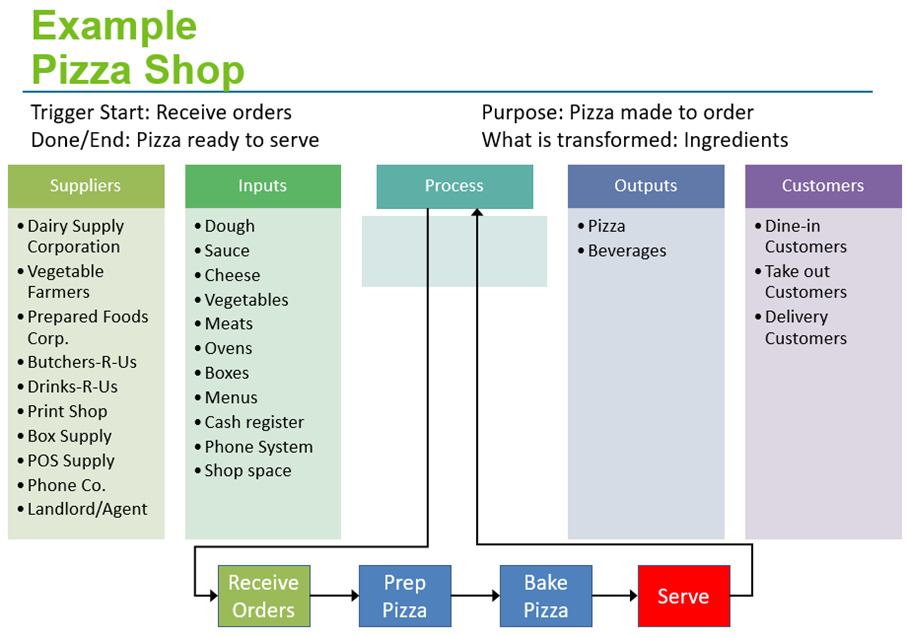Written by: David Larsen, PSP, PMP, LSSBB, Contributing Columnist
As the leader of a new DMAIC project or continuous improvement initiative, visualizing the process is a key first step to understanding the current state and identifying opportunities for improvement. To accomplish this first step of visualization, a tool to consider using in the define and measure phase is SIPOC.
What is SIPOC?
SIPOC is a type of high-level process map, which illustrates the flow of materials, information, or inputs, organized into categories titled Supplier, Inputs, Process, Outputs, and Customer. This visual tool helps identify relevant elements, current understanding, and potential gaps in a process before serious project work begins. A SIPOC diagram can be used as a scoping document or pre-work element with business analysis to understand relationships with owners or stakeholders of the process.
As a project leader and influencer, you have an opportunity to introduce principles attributed to Dr. Shigeo Shingo as the basis for building a sustainable culture of operational excellence. Principles that align with the SIPOC map include encouraging systemic thinking and focusing on the process.
Creating a SIPOC is a “hands-on” activity that requires a team. The benefit of a SIPOC map is in the visualization, produced by the participation and collaboration of the team. Supporting this team exercise depends on the setting for the team meeting. For an in-person meeting, tools include a smartboard or whiteboard, dry-erase markers, sticky notes, and pens. For a virtual meeting, work with a productivity tool that is comfortable. Collecting the information from the team is paramount. Post-meeting, you will take the opportunity to format the collected information and share the draft SIPOC with the team for finalizing.
Building the SIPOC
Begin in the middle of the SIPOC, with the process. Draw the process under evaluation into 4-8 sequential steps or activities. Keeping in mind, this is a high-level perspective of the process. These process steps will typically transform, adding value to inputs and yield outputs. With an existing process, this may be a straight-forward conversation with the team. For a process that is to be created through this project, map the process as best understood by the team. As project leader, facilitate the discussion in a way that’s collaborative and respectful of the team members, keeping the focus on defining the high-level process steps. Teams may tend to “dive right into details” or jump ahead to solutions. When this occurs, capture the thoughts and brainstorming in a parking lot area and guide the team back to the process steps.
Continue this facilitation process with the team and ask leading questions to complete each step of the SIPOC.
Outputs – What product(s), service(s), or information has been created or resulted from the process? Has a transformation occurred because of the process? Capture the feedback from the team. All information provided by the team is valuable and can be refined or clarified later.
Customer – Are the customers internal or external to the process? To the department? To the organization? Each step along the SIPOC map is an opportunity to question the team, discuss the current process, and identify gaps, to help connect dots through the conversation.
Inputs – What material(s), utility, component(s), tool(s), equipment, service(s), or information is used or consumed by the process to result in outputs? What supports the process to function as expected or necessary?
Supplier – Who or what supplies or provides the inputs required by the process? Is the supplier or provider internal or external?
SIPOC maps are useful for facilitating a discussion and helping team members to level-set knowledge and understanding a process for continuous improvement. To emphasize the needs of the customer, start with the customer and work upstream to the supplier. SIPOC maps can provide a visual foundation for the team with a high-level process map, or to define a new process.
Bio:
David is a certified Planning and Scheduling Professional, certified Project Management Professional (PMP®), Lean Six Sigma Black Belt, author, and podcast guest with more than 20 years of experience in healthcare, manufacturing, quality, and process improvement. Success comes from challenging the current state and asking tough questions. He coaches and develops others while practicing servant leadership; striving to establish collaborative and trustful relationships with individuals at all levels. He has experience leading large and complex cross functional project teams, coaching team members, and facilitating for success. A principle that he believes to be fundamental is learning to take every challenge as either a gateway to success or an opportunity to learn.
Social Media:

